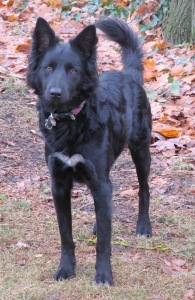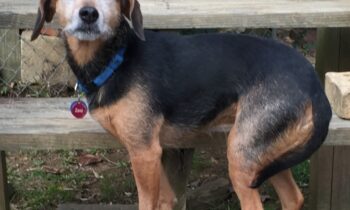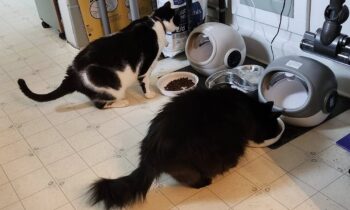
It’s the holidays. Your house is full of relatives and friends, or maybe you’re visiting away from home this year. Living areas are full of breakables, valuables, and food that’s great for humans but not for pets. Outside, there may be bad weather or—even worse for some pets—fireworks!
What’s a cat or dog or bird or ferret to do?
Stay safe!
You’ve heard the stories.
You’ve watched the videos.
You know how dangerous the “happy” holidays can be for pets who are left unsupervised . . . even for a few seconds! I’ve been reading this week about the emergency care required for a newly adopted greyhound who ate an ornament off a Christmas tree. He was lucky: he’d chewed it up so well that it appears to be passing, shall we say, naturally, without internal damage. His very experienced owners are still waiting to see if any big pieces of the ornament show on the X-rays. Pieces that might not pass easily—pieces that must be removed by surgery. Think of the guilt you’d feel if that happened to your pet. Think of the expense as well. Emergency vet rates are usually much higher than regular veterinary visits, plus there could be follow-ups, chronic problems, and more dollars spent on this dog’s health for the rest of his life as a result of just a few seconds’ inattention. Not good!
What’s the alternative?
Management!
Make some rules. No pets allowed . . . in the room with the tree, in the kitchen when we’re cooking, in the dining room when we’re eating, alone in the “danger zone” of holiday celebrations at all!
It seems extreme.
It keeps pets safe.

Trainers tend to be pragmatic—we try to do what works—so it’s not uncommon for us to decorate the perfect tree, display it in a place of honor in our home . . . and surround it with an exercise pen to protect the tree from our pets and the pets from our tree. It may not be pretty, but it sure is safe!
I had two cats, four dogs, and a constant turnover of canine visitors (trainees straight from the animal shelter) when my ex built a riser for our holiday tree: a foot-and-a-half high, solid wood with sliders on the corners so it could move easily without damaging the hardwood floors, and four feet square. To that very heavy base was attached—yes, with nuts and bolts—our very sturdy tree stand. When the animals were allowed in the room—only with human supervision, of course—there was really no chance they could knock over the tree even with the most enthusiastic tail wagging. There was also no way they could reach the most fragile of decorations because those were up high. All we put on the lower branches were relatively safe unbreakable items, ones that were boring even to the cats. The tree stand and the riser were covered with a tree skirt, and our six foot tree stood much taller than six feet, making it conveniently viewable in full through our living room window. It was lovely.
I have also been known to wire trees to walls with eye hooks and “invisible” fishing line with an appropriate tensile strength. I do that in memory of a cat that belonged to my mother, who visited one Christmas from California . . . with her cat, who was not at all pleased with the trip.
We were all hanging out in our bathrobes on the morning after Christmas when there was a huge crash from the front room. We ran in to find our tall skinny tree on the floor and the cat exiting at a full run, tail puffed, an alarmed look on her face. We figured the cat took a flying leap and landed in the tree’s upper half, which flung it to the floor. Tree limbs were broken, ornaments were smashed, there was a lot of clean-up, and the tree never looked quite itself again. (Still, it was not as direct a message as the steaming pile of cat poop the little sweetheart left on my bed exactly in the center of my tie-dyed sheets on the morning before my mom returned home. That was much, much worse.)
Do you have doors?
Close ’em!
Do you not have doors?
Consider investing in an attractive barrier with an opening for humans to walk through. Such fancy versions of “baby gates” for dogs are now available for almost any width or conformation of space, and they’re available in nice hardwoods that can match your decor. Some install by attaching to your walls, some are movable for use in varied locations. They work well for open-plan rooms if you’d like to keep your dog where you can see him without allowing him access to the “dangerous” part of the room. Unless your dog is a prodigious jumper or very fond of chewing wood, these barriers are great when you are there. (However, do not expect this sort of gating to keep cats out. They jump right over it.)
There’s also absolutely nothing wrong with keeping your dog on a leash in the house! You can attach that leash to your belt or loop it around your waist to keep your hands free. The dog will be beside you at all times because he’ll really have no choice. Add treats for cooperation and you’re also training for walking on a leash outside! Most important, you will not be able to forget your dog is there.
Your best bet for dog containment is, as always, a crate.
Now is your chance to spoil your dog safely by crating him in a quiet room (although some dogs seem to appreciate having a radio turned on nearby) where he can peacefully snooze after snacking on some wonderful home-made treats you’ve prepared for just this festive time. Don’t forget to take him outside often—on a leash if you don’t have a fenced yard—and make sure he gets enough exercise to wear off any boredom he might feel. Offer him low-stress options to interact with visitors and make sure your visitors know the rules. Make those rules easy for them to follow. (An acquaintance told me she puts a sign on her bird’s cage reminding visitors not to feed it. Great idea to avoid nagging your friends!) Reward your visitors for following the rules. Notice, acknowledge, and thank them for their cooperation!
Next week, tasty treats for pets . . . home-made!



